A Resilience Analysis of a Medical Mask Supply Chain during the COVID-19 Pandemic: A Simulation Modeling Approach
Abstract
:1. Introduction
- (1)
- How has the COVID-19 pandemic impacted the operational and financial performance of mask supply chains?
- (2)
- How to find the location of backup facilities and optimize the mask inventory of backup facilities?
- (3)
- How to measure and improve the mask supply chain resilience and risk management?
2. Literature Review
2.1. Strategies to Improve Supply Chain Resilience
2.2. Location-Allocation Problem for Relief Center/Humanitarian Logistics
2.3. Simulation Modeling
3. Case Studies and Simulation Model
3.1. Methods
3.2. Case Study
3.3. Simulation Model
- Factory disruption in the mask supply chain;
- The pandemic propagates to distribution centers;
- The pandemic further propagates to the market (demand increases by 10 times).
| Type | Indicators |
|---|---|
| Finance | Profit; Revenue; Total Cost; Other indicators |
| Inventory | Available Inventory; Available Inventory Backlog; On-hand Inventory |
| ELT Service Level | ELT Service Level by Orders/Products/Revenue |
| Demand | Demand (Products Backlog); Demand Placed (Products) by Customer; Demand Received (Products) |
| Lead Time | Lead Time; Max Lead Time; Mean Lead Time |
4. Experimental Results and Analysis
4.1. Performance of SC without the Epidemic
4.2. Performance of SC with the Epidemic
4.2.1. Factories Disruption
| Scenario | Time | Profit | Revenue | Total Cost | ELT |
|---|---|---|---|---|---|
| 1 | 0 | 1,533,659.018 | 2,328,480 | 794,820.982 | 1.000 |
| 2 | 30 | 1,444,515.296 | 2,328,480 | 883,964.704 | 1.000 |
| 3 | 45 | 1,439,485.154 | 2,328,480 | 888,994.846 | 0.956 |
| 4 | 60 | 1,415,376.715 | 2,328,480 | 913,103.284 | 0.912 |
4.2.2. The Epidemic Propagates to Distribution Centers
| Scenario | Time | Profit | Revenue | Total Cost | ELT |
|---|---|---|---|---|---|
| 5 | 30 30 | 1,254,931.776 | 2,134,440 | 879,508.224 | 0.917 |
| 6 | 30 45 | 1,166,057.556 | 2,005,080 | 839,022.444 | 0.861 |
| 7 | 30 60 | 1,120,894.358 | 1,940,400 | 819,505.642 | 0.833 |
| 9 | 45 45 | 1,166,057.556 | 2,005,080 | 839,022.444 | 0.861 |
| 10 | 45 60 | 1,120,894.358 | 1,940,400 | 819,505.642 | 0.833 |
| 11 | 60 60 | 1,120,894.358 | 1,940,400 | 819,505.642 | 0.833 |
4.2.3. The Epidemic Further Propagates to the Market (Demand Increases by Ten Times)
| Scenario | Time | Profit | Revenue | Total Cost | ELT |
|---|---|---|---|---|---|
| 12 | 30 30 30 | 1,101,177.029 | 4,551,480 | 3,450,302.971 | 0.128 |
| 13 | 30 30 45 | 11,011,77.029 | 4,551,480 | 3,450,302.971 | 0.128 |
| 14 | 30 30 60 | 1,101,177.029 | 4,551,480 | 3,450,302.971 | 0.128 |
| 15 | 30 45 45 | 1,001,651.986 | 4,176,720 | 3,175,068.014 | 0.125 |
| 16 | 30 45 60 | 1,001,651.986 | 4,176,720 | 3,175,068.014 | 0.125 |
| 17 | 30 60 60 | 1,103,039.443 | 4,143,120 | 3,040,080.557 | 0.123 |
| 18 | 45 45 45 | 1,001,651.986 | 4,176,720 | 3,175,068.014 | 0.125 |
| 19 | 45 45 60 | 1,001,651.986 | 4,176,720 | 3,175,068.014 | 0.125 |
| 20 | 45 60 60 | 1,103,039.443 | 4,143,120 | 3,040,080.557 | 0.123 |
| 21 | 60 60 60 | 1,103,039.443 | 4,143,120 | 3,040,080.557 | 0.123 |
5. Implementation and Results of Backup Facility
5.1. Location of Backup Facilities
| Name | Latitude | Longitude | |
|---|---|---|---|
| 1 | GFA DC 3 | 38.828 | 103.548 |
| 2 | GFA DC 2 | 35.017 | 97.805 |
| 3 | GFA DC | 33.168 | 104.993 |
| 4 | FC Xingtai | 37 | 115 |
| 5 | FC Lishui | 28.46 | 119.91 |
| 6 | DC Wuhan | 30.583 | 114.267 |
| 7 | DC Shenzhen | 22.546 | 114.068 |
| 8 | DC Shanghai | 31.222 | 121.458 |
| 9 | DC Chengdu | 30.667 | 104.067 |
| 10 | DC Beijing | 39.907 | 116.397 |
5.2. Inventory Optimization of Backup Facilities
6. Analysis of Economic Benefits and Resilience of Redesigned Mask Supply Chain
6.1. Analysis of Economic Benefits
6.2. Risk Analysis and Resilience
7. Conclusions and Future Research
Author Contributions
Funding
Institutional Review Board Statement
Informed Consent Statement
Data Availability Statement
Acknowledgments
Conflicts of Interest
References
- UNDRR. The Human Cost of Disasters 2000. Available online: http://geographyandyou.com/human-cost-of-disasters-2000-2019/ (accessed on 16 October 2020).
- SRI. Natural Catastrophes in 2020: Secondary Perils in the Spotlight, but Don’t Forget Primary-Peril Risks. Available online: https://www.swissre.com/institute/research/sigma-research/sigma-2021-01.html (accessed on 30 May 2021).
- GPMB. A World at Risk: Annual Report on Global Preparedness for Health Emergencies. Available online: https://apps.who.int/gpmb/assets/annual_report/GPMB_Annual_Report_English.pdf (accessed on 10 October 2020).
- Bowles, J.; Hjort, J.; Melvin, T.; Werker, E. Ebola, jobs and economic activity in Liberia. J. Epidemiol. Community Health 2016, 70, 271–277. [Google Scholar] [CrossRef] [PubMed] [Green Version]
- World Bank. The Economic Impact of the 2014 Ebola Epidemic: Short and Medium Term Estimates for West Africa. Available online: https://www.worldbank.org/en/region/afr/publication/the-economic-impact-of-the-2014-ebola-epidemic-short-and-medium-term-estimates-for-west-africa (accessed on 8 October 2014).
- Huber, C.; Finelli, L.; Stevens, W. The Economic and Social Burden of the 2014 Ebola Outbreak in West Africa. J. Infect. Dis. 2018, 218, S698–S704. [Google Scholar] [CrossRef] [PubMed]
- World Bank. Annual Report 2021: Supporting Countries in Unprecedented Times. Available online: https://www.worldbank.org/en/about/annual-report#anchor-annual (accessed on 1 October 2021).
- Antolini, A. The Impact of COVID-19 Pandemic on the European Automobile Industry. Available online: https://www.jttri.or.jp/document/2020/andrea78.pdf (accessed on 18 May 2020).
- Ribeiro, J.P.; Barbosa-Povoa, A. Supply Chain Resilience: Definitions and Quantitative Modelling Approaches—A literature review. Comput. Ind. Eng. 2018, 115, 109–122. [Google Scholar] [CrossRef]
- WTO. Mask Use in the Context of COVID-19. Available online: https://www.who.int/publications/i/item/advice-on-the-use-of-masks-in-the-community-during-home-care-and-in-healthcare-settings-in-the-context-of-the-novel-coronavirus-(2019-ncov)-outbreak (accessed on 1 December 2020).
- WTO. Shortage of Personal Protective Equipment Endangering Health Workers Worldwide. Available online: https://www.who.int/news/item/03-03-2020-shortage-of-personal-protective-equipment-endangering-health-workers-worldwide (accessed on 3 March 2020).
- Shufan, Z.; Kefan, X.; Ping, G. Dynamic Adjustment Mechanism and Differential Game Model Construction of Mask Emergency Supply Chain Cooperation Based on COVID-19 Outbreak. Sustainability 2021, 13, 1115. [Google Scholar]
- Ahmadi-Javid, A.; Hoseinpour, P. Service system design for managing interruption risks: A backup-service risk-mitigation strategy. Eur. J. Oper. Res. 2019, 274, 417–431. [Google Scholar] [CrossRef]
- Ratick, S.; Meacham, B.; Aoyama, Y. Locating backup facilities to enhance supply chain disaster resilience. Growth Chang. 2008, 39, 642–666. [Google Scholar] [CrossRef]
- Ivanov, D. Supply Chain Risks, Disruptions, and Ripple Effect. In Introduction to Supply Chain Resilience: Management, Modelling, Technology; Springer International Publishing: Cham, Switzerland, 2021; pp. 1–28. [Google Scholar]
- Ivanov, D. Predicting the impacts of epidemic outbreaks on global supply chains: A simulation-based analysis on the coronavirus outbreak (COVID-19/SARS-CoV-2) case. Transp. Res. Part E Logist. Transp. Rev. 2020, 136, 101922. [Google Scholar] [CrossRef]
- Mandal, S. An Empirical Investigation into Supply Chain Resilience. IUP J. Supply Chain Manag. 2012, 9, 46–61. [Google Scholar] [CrossRef]
- Li, H.; Pedrielli, G.; Lee, L.H.; Chew, E.P. Enhancement of supply chain resilience through inter-echelon information sharing. Flex. Serv. Manuf. J. 2016, 29, 260–285. [Google Scholar] [CrossRef]
- El Baz, J.; Ruel, S. Can supply chain risk management practices mitigate the disruption impacts on supply chains’ resilience and robustness? Evidence from an empirical survey in a COVID-19 outbreak era. Int. J. Prod. Econ. 2021, 233, 107972. [Google Scholar] [CrossRef]
- Hasani, A. Resilience cloud-based global supply chain network design under uncertainty: Resource-based approach. Comput. Ind. Eng. 2021, 158, 107382. [Google Scholar] [CrossRef]
- Ponomarov, S.Y.; Holcomb, M.C. Understanding the concept of supply chain resilience. Int. J. Logist. Manag. 2009, 20, 124–143. [Google Scholar] [CrossRef]
- Belhadi, A.; Kamble, S.; Jabbour, C.J.C.; Gunasekaran, A.; Ndubisi, N.O.; Venkatesh, M. Manufacturing and service supply chain resilience to the COVID-19 outbreak: Lessons learned from the automobile and airline industries. Technol. Forecast. Soc. Chang. 2021, 163, 120447. [Google Scholar] [CrossRef] [PubMed]
- Johnson, N.; Elliott, D.; Drake, P. Exploring the role of social capital in facilitating supply chain resilience. Supply Chain Manag. 2013, 18, 324–336. [Google Scholar] [CrossRef]
- Jüttner, U.; Maklan, S. Supply chain resilience in the global financial crisis: An empirical study. Supply Chain Manag. 2013, 16, 246–259. [Google Scholar] [CrossRef]
- Gruzauskas, V.; Vilkas, M. Managing Capabilities for Supply Chain Resilience Through it Integration. Econ. Bus. 2017, 31, 30–43. [Google Scholar] [CrossRef] [Green Version]
- Massari, G.F.; Giannoccaro, I. Investigating the effect of horizontal coopetition on supply chain resilience in complex and turbulent environments. Int. J. Prod. Econ. 2021, 237, 108150. [Google Scholar] [CrossRef]
- Leat, P.; Revoredo-Giha, C. Risk and resilience in agri-food supply chains: The case of the ASDA PorkLink supply chain in Scotland. Supply Chain Manag. Int. J. 2013, 18, 219–231. [Google Scholar] [CrossRef]
- Lohmer, J.; Bugert, N.; Lasch, R. Analysis of resilience strategies and ripple effect in blockchain-coordinated supply chains: An agent-based simulation study. Int. J. Prod. Econ. 2020, 228, 107882. [Google Scholar] [CrossRef]
- Rajesh, R. Technological capabilities and supply chain resilience of firms: A relational analysis using Total Interpretive Structural Modeling (TISM). Technol. Forecast. Soc. Chang. 2017, 118, 161–169. [Google Scholar] [CrossRef]
- Belhadi, A.; Mani, V.; Kamble, S.S.; Khan, S.A.R.; Verma, S. Artificial intelligence-driven innovation for enhancing supply chain resilience and performance under the effect of supply chain dynamism: An empirical investigation. Ann. Oper. Res. 2021, 297, 1–26. [Google Scholar] [CrossRef] [PubMed]
- Gu, M.; Yang, L.; Huo, B. The impact of information technology usage on supply chain resilience and performance: An ambidexterous view. Int. J. Prod. Econ. 2021, 232, 107956. [Google Scholar] [CrossRef] [PubMed]
- Ivanov, D.; Dolgui, A. A digital supply chain twin for managing the disruption risks and resilience in the era of Industry 4.0. Prod. Plan. Control 2020, 32, 775–788. [Google Scholar] [CrossRef]
- Mubarik, M.S.; Naghavi, N.; Mubarik, M.; Kusi-Sarpong, S.; Khan, S.A.; Zaman, S.I.; Kazmi, S.H.A. Resilience and cleaner production in industry 4.0: Role of supply chain mapping and visibility. J. Clean. Prod. 2021, 292, 126058. [Google Scholar] [CrossRef]
- Min, H. Blockchain technology for enhancing supply chain resilience. Bus. Horiz. 2019, 62, 35–45. [Google Scholar] [CrossRef]
- Quan, Z.; Krikke, H.; Caniels, M. The effects of different types of supply chain integration under disruptions: A simulation study. In Proceedings of the 20th International Symposium on Logistics, Bologna, Italy, 5–8 July 2015. [Google Scholar]
- Jung, J.Y.; Blau, G.; Pekny, J.F.; Reklaitis, G.V.; Eversdyk, D. A simulation based optimization approach to supply chain management under demand uncertainty. Comput. Chem. Eng. 2004, 28, 2087–2106. [Google Scholar] [CrossRef]
- Mele, F.D.; Guillén, G.; Espu, A.A.; Puigjaner, L. A Simulation-Based Optimization Framework for Parameter Optimization of Supply-Chain Networks. Ind. Eng. Chem. Res. 2006, 45, 1445–1451. [Google Scholar] [CrossRef]
- Timperio, G.; Tiwari, S.; Lee, C.K.; Samvedi, A.; Souza, R.D. Integrated Decision Support Framework for Enhancing Disaster Preparedness: A Pilot application in Indonesia. Int. J. Disaster Risk Reduct. 2020, 51, 101773. [Google Scholar] [CrossRef]
- Ivanov, D. Revealing interfaces of supply chain resilience and sustainability: A simulation study. Int. J. Prod. Res. 2018, 56, 3509–3525. [Google Scholar] [CrossRef] [Green Version]
- Kaur, G.; Pasricha, S.; Kathuria, G. Resilience Role of Distribution Centers amid COVID-19 Crisis in Tier-A Cities of India: A Green Field Analysis Experiment. J. Oper. Strateg. Plan. 2020, 3, 226–239. [Google Scholar] [CrossRef]
- Lozano-Diez, J.; Marmolejo-Saucedo, J.; Aguilar, R.R. Designing a resilient supply chain: An approach to reduce drug shortages in epidemic outbreaks. EAI Endorsed Trans. Pervasive Health Technol. 2020, 6, e2. [Google Scholar] [CrossRef]
- Chern, C.C.; Chen, Y.L.; Kung, L.C. A heuristic relief transportation planning algorithm for emergency Supply Chain Management. Int. J. Comput. Math. 2010, 87, 1638–1664. [Google Scholar] [CrossRef]
- Abounacer, R.; Rekik, M.; Renaud, J. An exact solution approach for multi-objective location–transportation problem for disaster response. Comput. Oper. Res. 2014, 41, 83–93. [Google Scholar] [CrossRef] [Green Version]
- Lin, Y.-H.; Batta, R.; Rogerson, P.A.; Blatt, A.; Flanigan, M. A logistics model for emergency supply of critical items in the aftermath of a disaster. Socio-Econ. Plan. Sci. 2011, 45, 132–145. [Google Scholar] [CrossRef]
- Alinaghian, M.; Aghaie, M.; Sabbagh, M.S. A mathematical model for location of temporary relief centers and dynamic routing of aerial rescue vehicles. Comput. Ind. Eng. 2019, 131, 227–241. [Google Scholar] [CrossRef]
- Liu, C.; Kou, G.; Peng, Y.; Alsaadi, F.E. Location-Routing Problem for Relief Distribution in the Early Post-Earthquake Stage from the Perspective of Fairness. Sustainability 2019, 11, 3420. [Google Scholar] [CrossRef] [Green Version]
- Rath, S.; Gutjahr, W.J. A math-heuristic for the warehouse location–routing problem in disaster relief. Comput. Oper. Res. 2014, 42, 25–39. [Google Scholar] [CrossRef]
- Boonmee, C.; Arimura, M.; Asada, T. Facility location optimization model for emergency humanitarian logistics. Int. J. Disaster Risk Reduct. 2017, 24, 485–498. [Google Scholar] [CrossRef]
- Bozorgi-Amiri, A.; Jabalameli, M.S.; Mirzapour Al-e-Hashem, S.M.J. A multi-objective robust stochastic programming model for disaster relief logistics under uncertainty. OR Spectr. 2011, 35, 905–933. [Google Scholar] [CrossRef]
- Fang, L.; Li, H. Multi-criteria decision analysis for efficient location-allocation problem combining DEA and goal programming. RAIRO-Oper. Res. 2015, 49, 753–772. [Google Scholar] [CrossRef]
- Hong, J.-D.; Jeong, K.Y. Cross-evaluation based super efficiency DEA approach to designing disaster recovery center location-allocation-routing network schemes. J. Humanit. Logist. Supply Chain Manag. 2020, 10, 485–508. [Google Scholar] [CrossRef]
- Moline, J.; Goentzel, J.; Gralla, E. Approaches for Locating and Staffing FEMA’s Disaster Recovery Centers. Decis. Sci. 2019, 50, 917–947. [Google Scholar] [CrossRef]
- Dekle, J.; Lavieri, M.S.; Martin, E.; Emir-Farinas, H.; Francis, R.L. A Florida County Locates Disaster Recovery Centers. Interfaces 2005, 35, 133–139. [Google Scholar] [CrossRef] [Green Version]
- Marmolejo-Saucedo, J.A.; Rodriguez-Aguilar, R.; Manuell-Barrera, O. Technical evaluation of the opening of facilities in the pharmaceutical industry: Optimization to supply chain in Mexico. IFAC-PapersOnLine 2019, 52, 2692–2697. [Google Scholar] [CrossRef]
- Prosser, W.; Folorunso, O.; McCord, J.; Roche, G.; Tien, M.; Hatch, B.; Spisak, C.; Genovese, E.; Pare, B.; Donatien, K.; et al. Redesigning immunization supply chains: Results from three country analyses. Vaccine 2021, 39, 2246–2254. [Google Scholar] [CrossRef]
- Ambulkar, S.; Blackhurst, J.; Grawe, S. Firm’s resilience to supply chain disruptions: Scale development and empirical examination. J. Oper. Manag. 2015, 33–34, 111–122. [Google Scholar] [CrossRef]
- Park, K.; Min, H.; Min, S. Inter-relationship among risk taking propensity, supply chain security practices, and supply chain disruption occurrence. J. Purch. Supply Manag. 2016, 22, 120–130. [Google Scholar] [CrossRef]
- Parast, M.M. The impact of R&D investment on mitigating supply chain disruptions: Empirical evidence from U.S. firms. Int. J. Prod. Econ. 2020, 227, 107671. [Google Scholar]
- Behdani, B.; Srinivasan, R. Managing Supply Chain Disruptions: An Integrated Agent-Oriented Approach; Espuña, A., Graells, M., Puigjaner, L., Eds.; Computer Aided Chemical Engineering; Elsevier: Amsterdam, The Netherlands, 2017; Volume 40, pp. 595–600. [Google Scholar]
- Sarkar, S.; Kumar, S. A behavioral experiment on inventory management with supply chain disruption. Int. J. Prod. Econ. 2015, 169, 169–178. [Google Scholar] [CrossRef]
- Heckmann, I. Towards Supply Chain Risk Analytics. In Fundamentals—Simulation—Optimization; Springer: Berlin/Heidelberg, Germany, 2016; pp. 131–162. [Google Scholar]
- Ivanov, D.; Dolgui, A.; Das, A.; Sokolov, B. Digital Supply Chain Twins: Managing the Ripple Effect, Resilience, and Disruption Risks by Data-Driven Optimization, Simulation, and Visibility. In Handbook of Ripple Effects in the Supply Chain; Ivanov, D., Dolgui, A., Sokolov, B., Eds.; Springer International Publishing: Cham, Switzerland, 2019; pp. 309–332. [Google Scholar]
- Patrinley, J.R.; Berkowitz, S.T.; Zakria, D.; Totten, D.J.; Kurtulus, M.; Drolet, B.C. Lessons from Operations Management to Combat the COVID-19 Pandemic. J. Med. Syst. 2020, 44, 129. [Google Scholar] [CrossRef]
- Roy, S.; Rabia, S.; Galimovich, K.B.; Vasilyevich, K.V.; Svetlana, D.D.; Lidia, V.V.; Natalia, A.P.; Viacheslav, Z.; Evgeny, N.; Nadezhda, K.; et al. Sustainable Closed-Loop Mask Supply Chain Network Design Using Mathematical Modeling and a Fuzzy Multi-Objective Approach. Sustainability 2021, 13, 5353. [Google Scholar]
- World Bank. A Shock Like No Other: The Impact of COVID-19 on Commodity Markets. Available online: https://pubdocs.worldbank.org/en/558261587395154178/CMO-April-2020-Special-Focus-1.pdf (accessed on 10 April 2020).
- Mahase, E. COVID-19: Are cloth masks still effective? And other questions answered. BMJ 2021, 372, n432. [Google Scholar] [CrossRef] [PubMed]
- Dolgui, A.; Ivanov, D.; Sokolov, B. Ripple effect in the supply chain: An analysis and recent literature. Int. J. Prod. Res. 2018, 56, 414–430. [Google Scholar] [CrossRef] [Green Version]
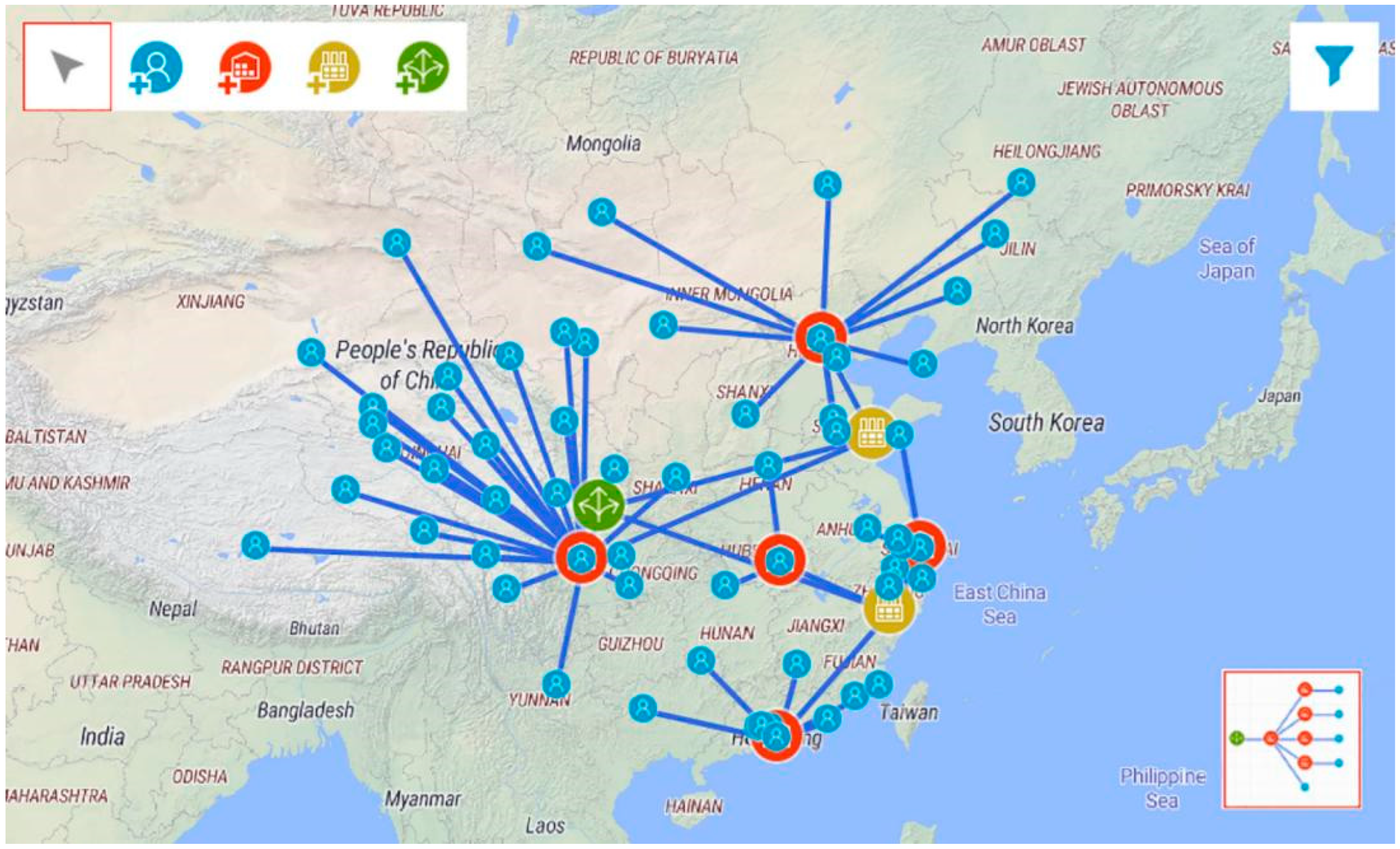
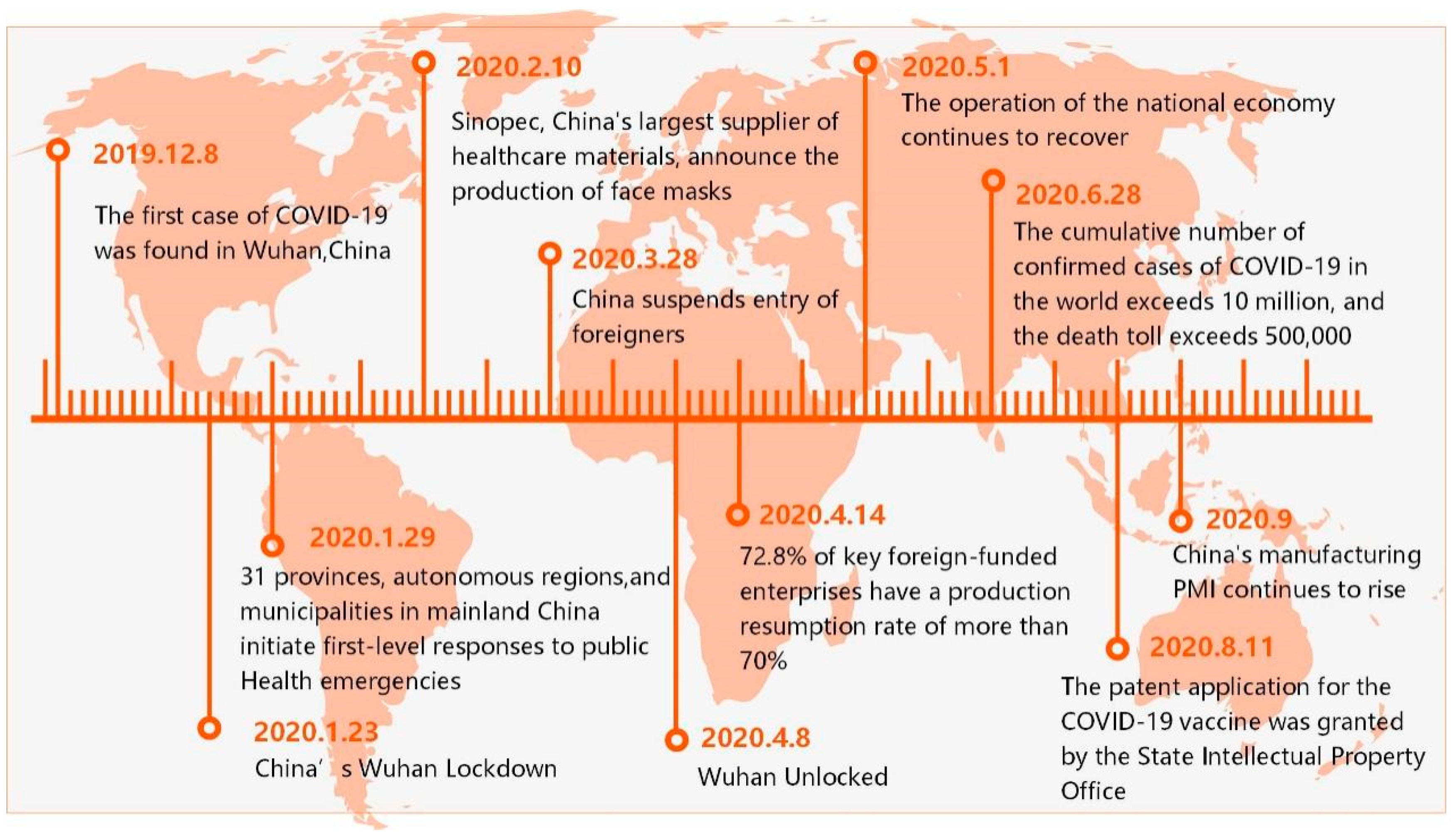
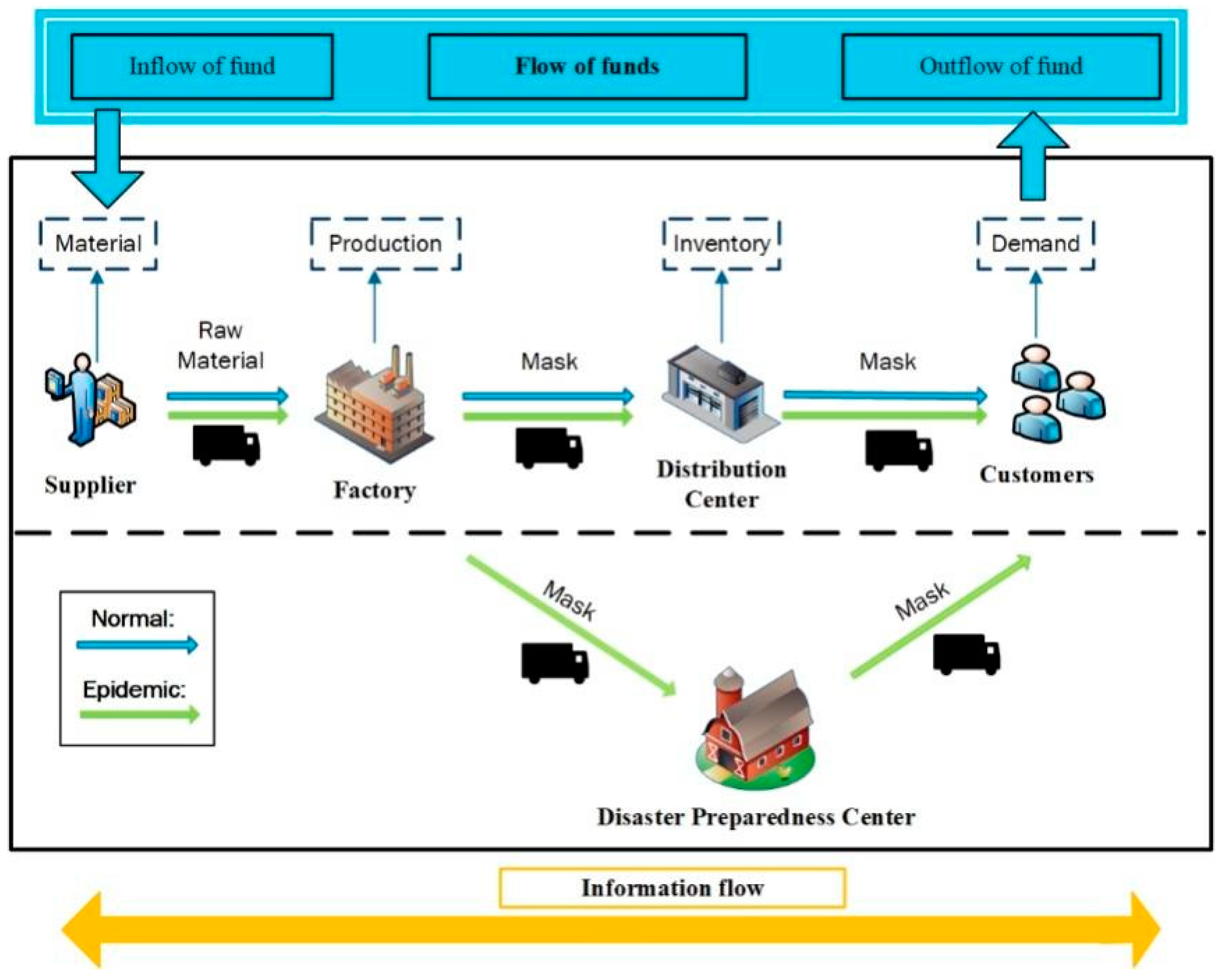


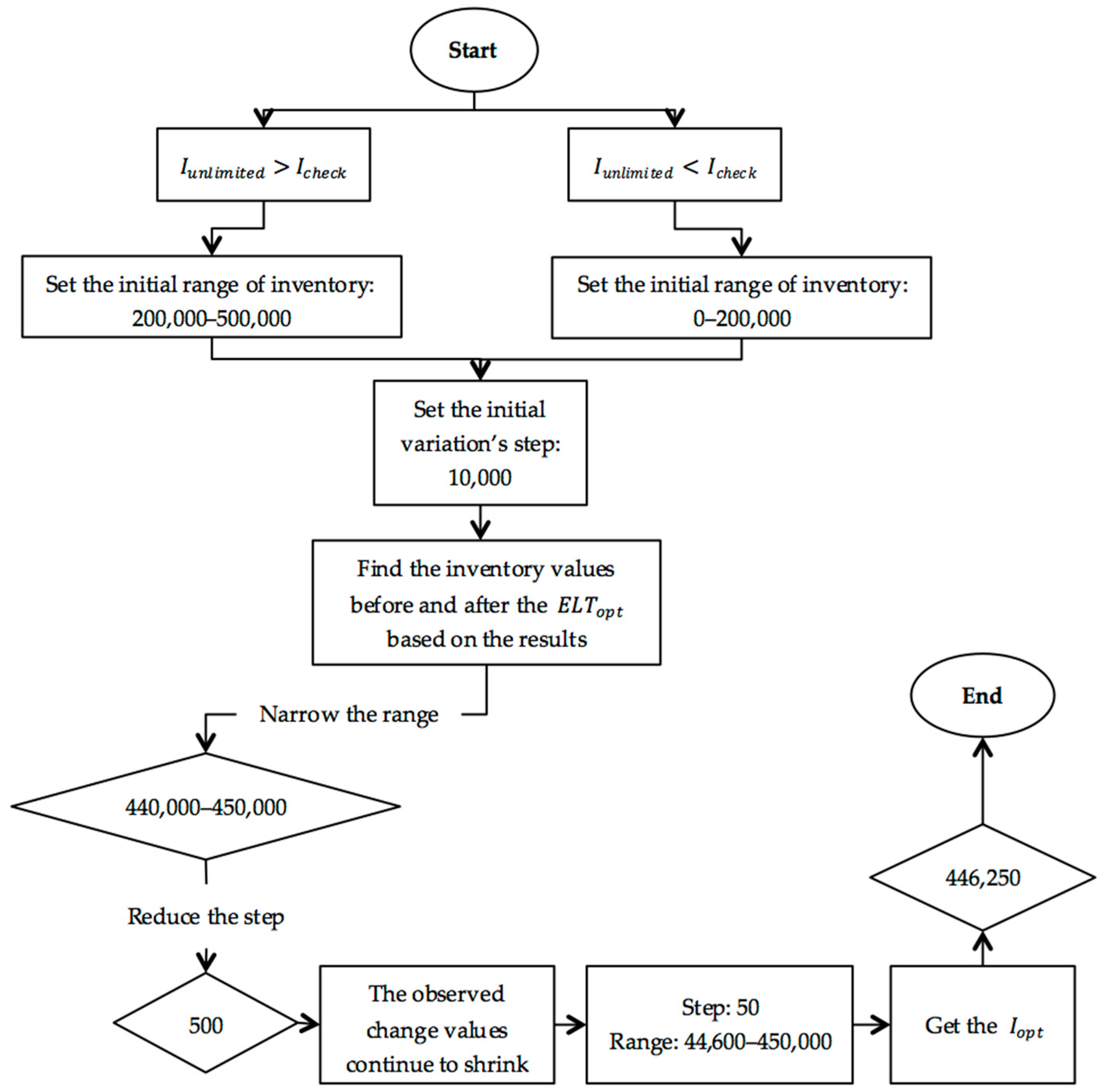
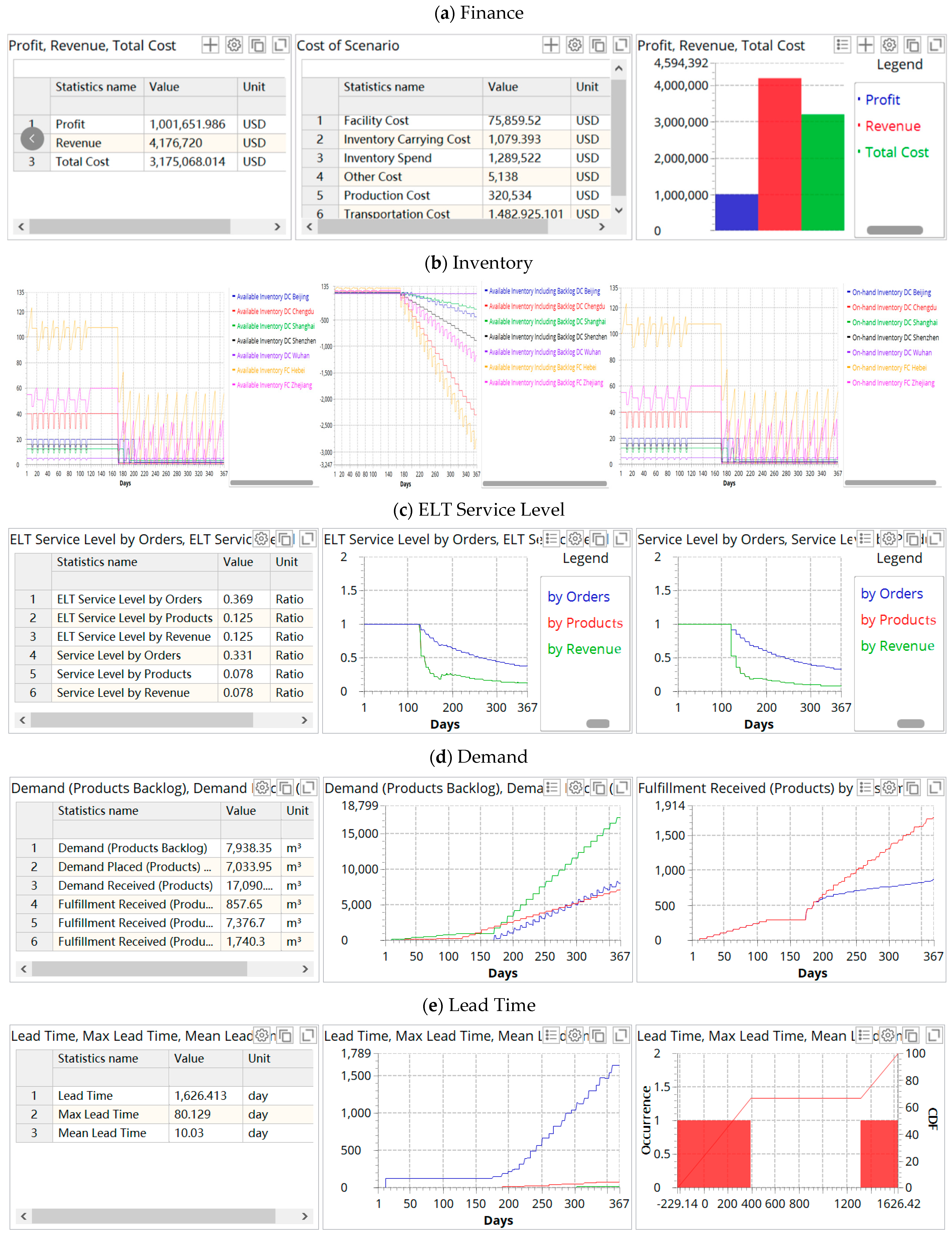
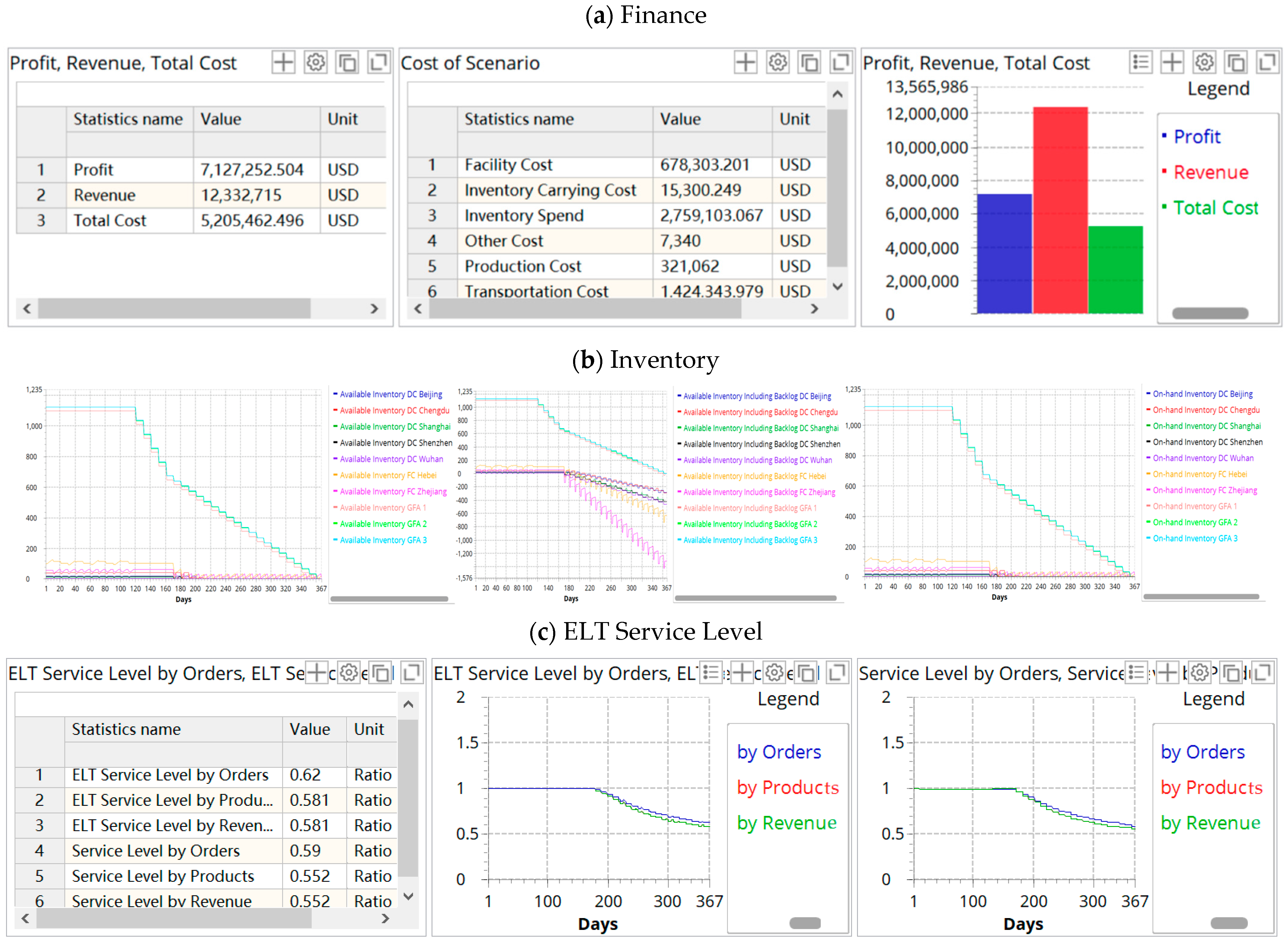
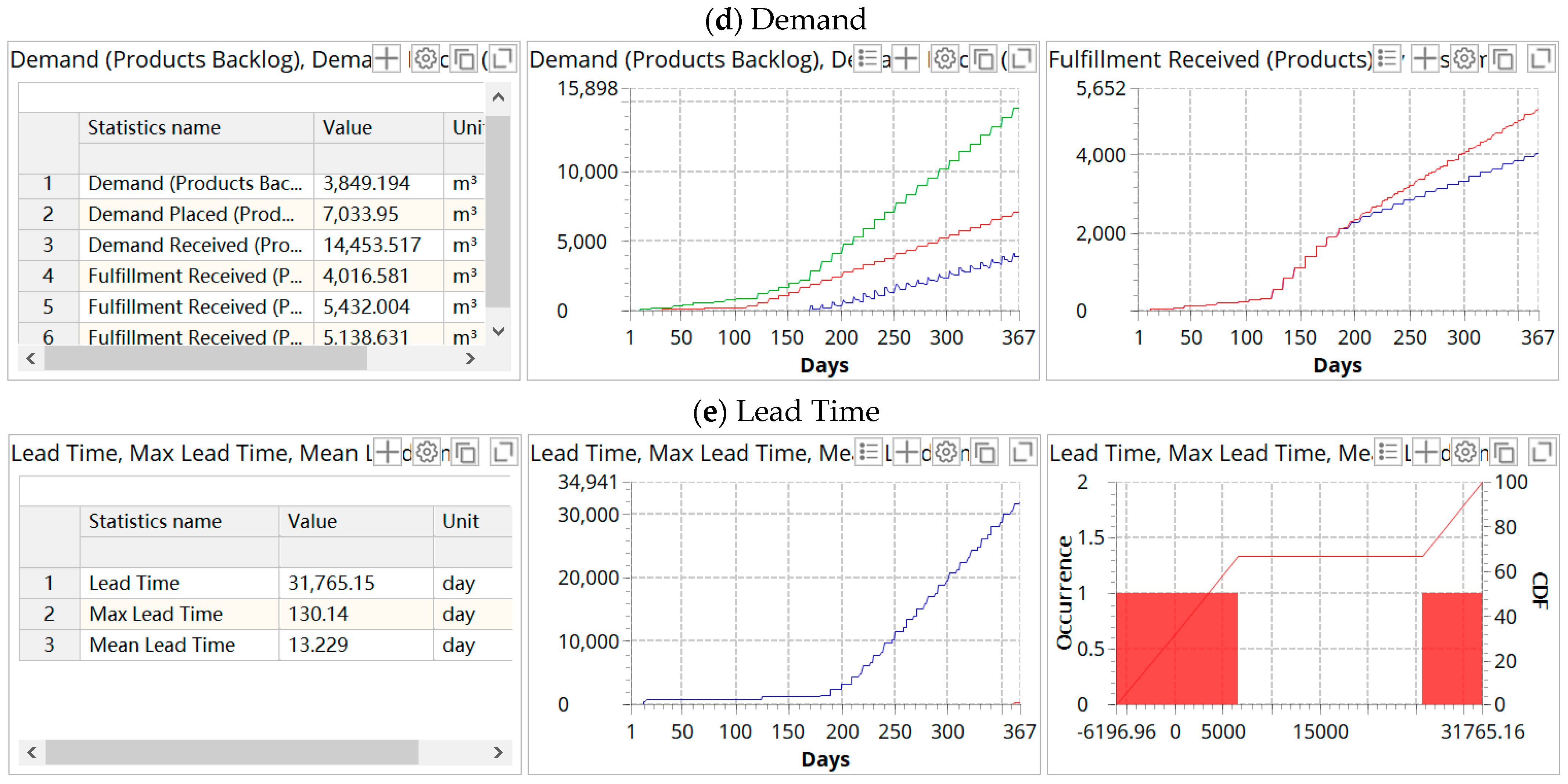


| 1 GFA | 2 GFA | 3 GFA | |
|---|---|---|---|
| 0.229 | 0.385 | 0.535 | |
| 0.410 | 0.508 | 0.580 | |
| 0.410 | 0.508 | 0.580 | |
| (446,250) | (281,350, 288,750) | (219,400, 224,600, 224,600) |
| Scenery | Profit | Revenue | Total Cost | Product Demand | Demand for Completion on Time | ELT |
|---|---|---|---|---|---|---|
| Scenario 18 | 1,001,651.986 | 417,6720 | 3,175,068.014 | 7033.95 | 857.65 | 0.125 |
| Redesigned scenario 18 | 7,127,252.504 | 1.2332715 | 5,205,462.495 | 7033.95 | 4009.706 | 0.581 |
Publisher’s Note: MDPI stays neutral with regard to jurisdictional claims in published maps and institutional affiliations. |
© 2022 by the authors. Licensee MDPI, Basel, Switzerland. This article is an open access article distributed under the terms and conditions of the Creative Commons Attribution (CC BY) license (https://creativecommons.org/licenses/by/4.0/).
Share and Cite
Zheng, Y.; Liu, L.; Shi, V.; Huang, W.; Liao, J. A Resilience Analysis of a Medical Mask Supply Chain during the COVID-19 Pandemic: A Simulation Modeling Approach. Int. J. Environ. Res. Public Health 2022, 19, 8045. https://doi.org/10.3390/ijerph19138045
Zheng Y, Liu L, Shi V, Huang W, Liao J. A Resilience Analysis of a Medical Mask Supply Chain during the COVID-19 Pandemic: A Simulation Modeling Approach. International Journal of Environmental Research and Public Health. 2022; 19(13):8045. https://doi.org/10.3390/ijerph19138045
Chicago/Turabian StyleZheng, Yi, Li Liu, Victor Shi, Wenxing Huang, and Jianxiu Liao. 2022. "A Resilience Analysis of a Medical Mask Supply Chain during the COVID-19 Pandemic: A Simulation Modeling Approach" International Journal of Environmental Research and Public Health 19, no. 13: 8045. https://doi.org/10.3390/ijerph19138045
APA StyleZheng, Y., Liu, L., Shi, V., Huang, W., & Liao, J. (2022). A Resilience Analysis of a Medical Mask Supply Chain during the COVID-19 Pandemic: A Simulation Modeling Approach. International Journal of Environmental Research and Public Health, 19(13), 8045. https://doi.org/10.3390/ijerph19138045







